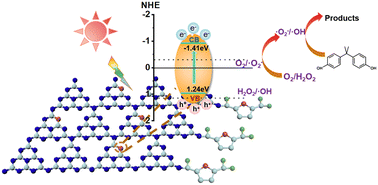Enhanced photocatalytic performance of thiophene-modified graphitic carbon nitrides as donor–acceptor conjugated organic polymers†
Abstract
Inherent structural defects of graphitic carbon nitride (g-C3N4) – in particular, the low separation efficiency that it demonstrates with respect to photogenerated carriers – have greatly limited its usefulness as the sole mechanism for inducing photocatalytic degradation in pollutants. Work-arounds have been developed over the years however; notably, the introduction of non-metallic elements and the adjustment of its energy band structure and electron transport processes have been found to enable it to maintain its non-metallic properties and improve its visible light photocatalytic performance. In this study, we synthesized a metal-free sulfur-doped graphitic carbon nitride (S-g-C3N4) using a copolymerization calcination method, and further incorporated thiophene (TA) using organic synthesis to create a composite photocatalyst (S-g-C3N4/TA) with a donor–acceptor (D–A) structure. Sulfur doping was found to broaden the absorption spectrum and improve the capacity for inducing separation of photogenerated carriers. The electron-rich TA and g-C3N4 formed a D–A electron transport structure through an amide bond, and this resulting D–A structure significantly enhanced the electron transfer rate of g-C3N4 – resulting in excellent photocatalytic performance. Through the synergistic effect of internal sulfur doping and external sulfur-containing functional groups, the photocatalytic activity was greatly enhanced, which facilitated a far more efficient degradation process with respect to BPA pollutants in water. Under simulated sunlight irradiation, the mineralization rate of BPA reached 63.1% over S-g-C3N4/TA. In summary, this study introduces a novel approach for designing photocatalysts based on non-metallic polymer-modified D–A structures, and provides valuable insights for the development of efficient photocatalytic systems.



 Please wait while we load your content...
Please wait while we load your content...